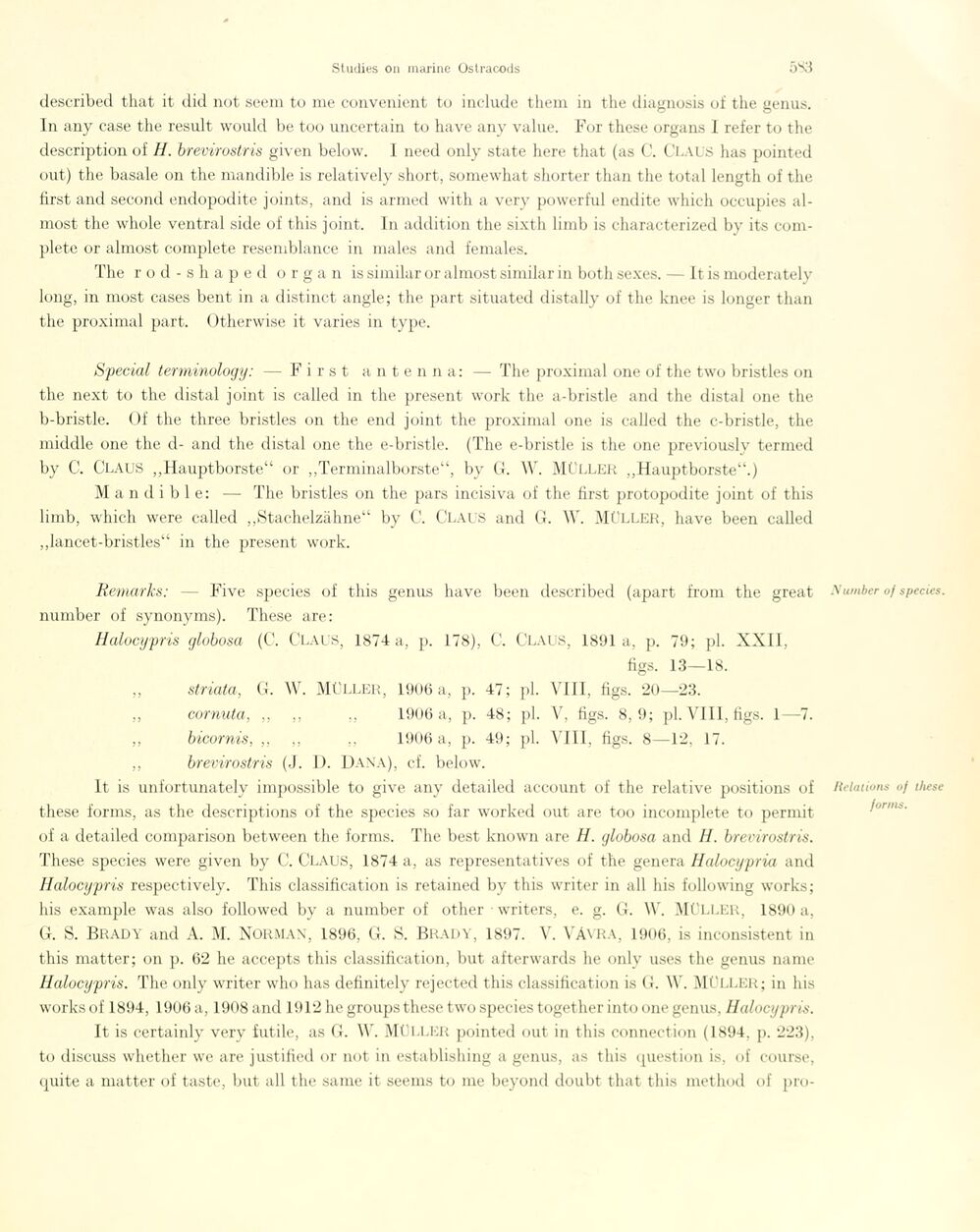
Full resolution (JPEG) - On this page / på denna sida - Sidor ...

<< prev. page << föreg. sida << >> nästa sida >> next page >>
Below is the raw OCR text
from the above scanned image.
Do you see an error? Proofread the page now!
Här nedan syns maskintolkade texten från faksimilbilden ovan.
Ser du något fel? Korrekturläs sidan nu!
This page has never been proofread. / Denna sida har aldrig korrekturlästs.
described that it did not seem to me convenient to include them in tbe diagnosis of the genus.
In any case the result would be too uncertain to have any value. For these organs I refer to the
description of H. brevirostris given below. 1 need only state here that (as C. Claus has pointed
out) the basale on the mandible is relatively short, somewhat shorter than the total length of the
first and second endopodite joints, and is armed with a very powerful endite which occupies
almost the whole ventral side of this joint. In addition the sixth limb is characterized by its
complete or almost complete resemblance in males and females.
The rod-shaped organ is similar or almost similar in both sexes. — It is moderately
long, in most cases bent in a distinct angle; the part situated distally of the knee is longer than
the proximal part. Otherwise it varies in type.
Special terminologi): — First antenna: — The proximal one of the two bristles on
the next to the distal joint is called in the present work the a-bristle and the distal one the
b-bristle. Of the three bristles on the end joint the proximal one is called the c-bristle, the
middle one the d- and the distal one the e-bristle. (The e-bristle is the one previouslv termed
by C. Claus „Hauptborste“ or „Terminalborste“, by G. W. Müller „Hauptborste“.)
Mandible: — The bristles on the pars incisiva of the first protopodite joint of this
limb, which were called „Stachelzähne“ by C. CLAUS and G. \\\ MÜLLER, have been called
„lancet-bristles“ in the present work.
Remarks: — Five species of this genus have been described (apart from the great
number of synonyms). These are:
Halocypris globosa (C. Claus, 1874 a, p. 178), C. CLAUS, 1891a, p. 79; pl. XXII,
figs. 13—18.
,, striata, G. W. MÜLLER, 1906 a, p. 47; pl. V III, figs. 20—23.
„ cornuta, ,, „ ,, 1906 a, p. 48; pl. V, figs. 8,9; pl. VIII, figs. 1—7.
,, bicornis, ,, ,, „ 1906 a, p. 49; pl. VIII, figs. 8—12, 17.
„ brevirostris (J. 1). Dana), cf. below.
It is unfortunately impossible to give any detailed account of the relative positions of
these forms, as the descriptions of the species so far worked out are too incomplete to permit
of a detailed comparison between the forms. The best known are H. globosa and H. brevirostris.
These species were given by C. Claus, 1874 a, as representatives of the genera Halocypria and
Halocypris respectively. This classification is retained by this writer in all his following works;
his example was also followed by a number of other writers, e. g. G. W. MÜLLER, 1890 a,
G. S. Brady and A. M. Norman, 1896, G. S. Brady, 1897. V. VàVRA, 1906, is inconsistent in
this matter; on p. 62 he accepts this classification, but afterwards he only uses the genus name
Halocypris. The only writer who has definitely rejected this classification is G. W. MÜLLER; in his
works of 1894, 1906 a, 1908 and 1912 he groups these two species together into one genus, Halocypris.
It is certainly very futile, as G. W. Müller pointed out in this connection (1894. p. 223),
to discuss whether we are justified or not in establishing a genus, as this question is, of course,
quite a matter of taste, but all the same it seems to me beyond doubt that this method of pro-
.V umher oj species.
Relations of these
forms.
<< prev. page << föreg. sida << >> nästa sida >> next page >>